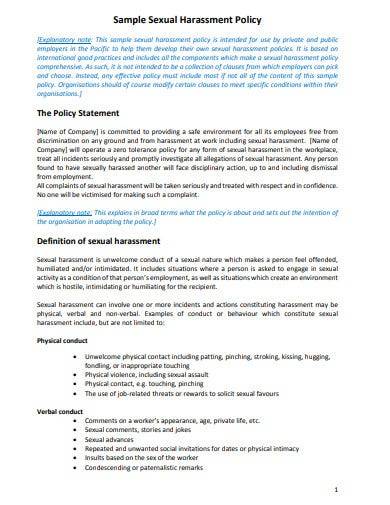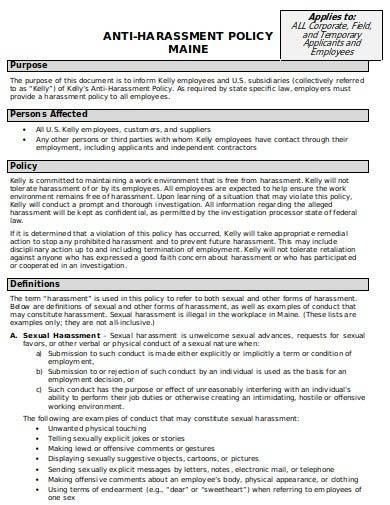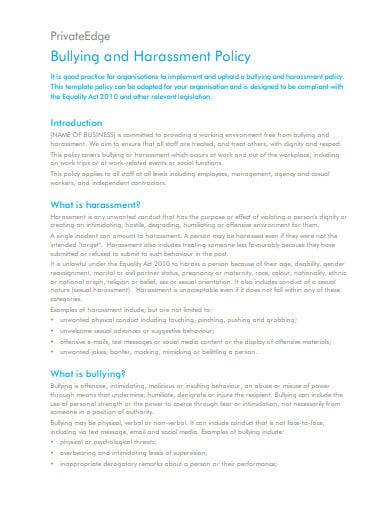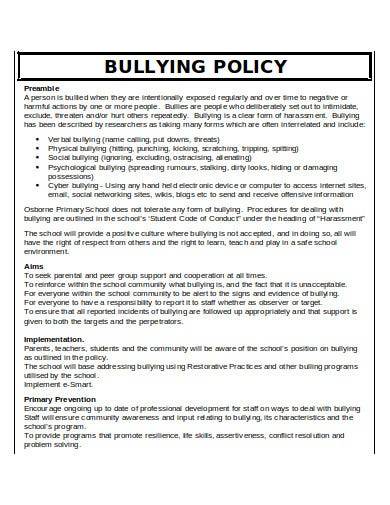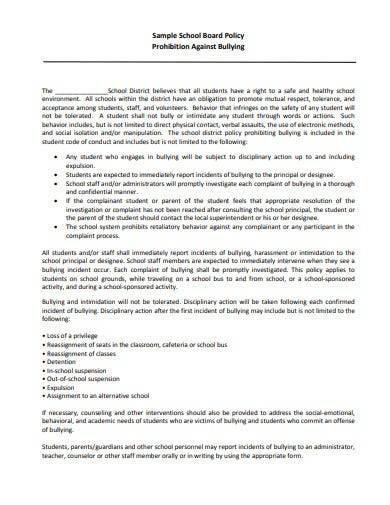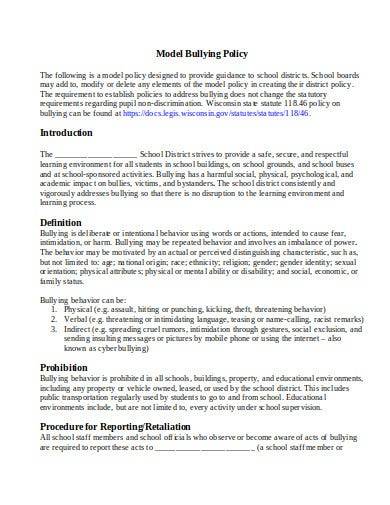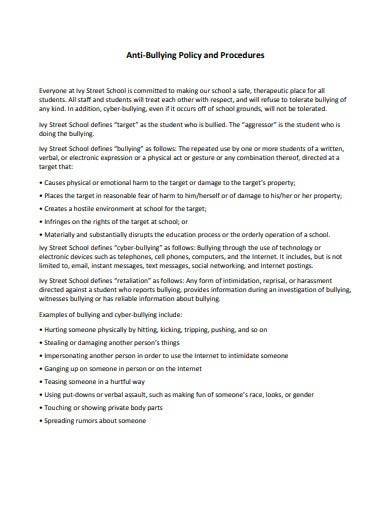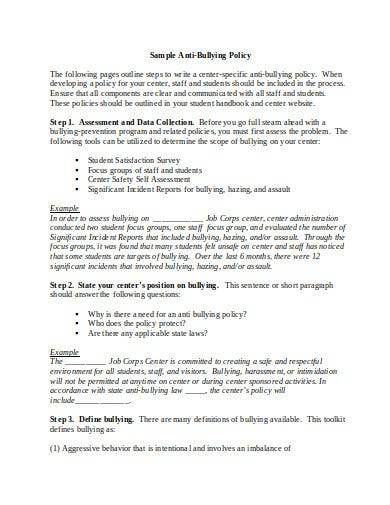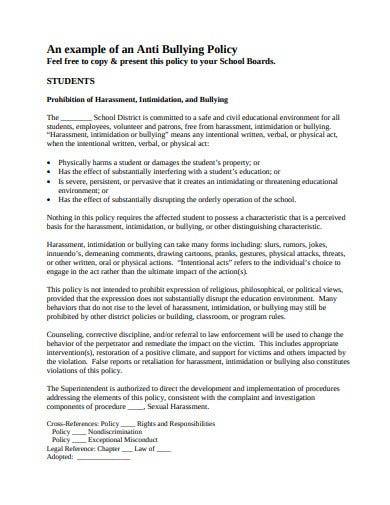Each jurisdiction, which includes all 50 of its states, the US territories and the District of Columbia addresses cases of bullying differently. Some states provided and established laws, policies, and regulations while some of them have created model policies that schools and other local educational institutions can adopt as they establish their own local laws, policies, and regulations. Districts and schools are required by most state laws, policies, and regulations to implement a bullying policy and procedure to enable effective investigation and response to cases related to bullying.
FREE 10+ Bullying Policy Samples
1. Sample Anti-Bullying Policy Template
2. Work Place Bullying and Harassment Policy
3. Sample Sexual Harassment Policy
4. Anti-Harassment Policy Template
5. Bullying and Harassment Policy Sample
6. Sample Bullying Policy Template
7. School Board Anti Bullying Policy Template
8. Model Bullying Policy Sample
9. Anti Bullying Policy and Procedure
10. Sample Anti-Bullying Policy
11. Standard Anti Bullying Policy
What is a Bullying Policy?
Bullying policies are sets of rules and guidelines that enable and support schools and other forms of educational institutions to create and maintain a safe and respectful learning place where students can learn and speak without the fear of being oppressed. Bullying is an anti-social behavior that affects not only the victim but the people around them as well. If this behavior ever happens, it is important that students are able to tell and be informed about how it should be handled and dealt with immediately and effectively.
How to Write and Implement Anti-Bullying Policies
With a clear and strong policy, students and their parents can ensure that the school their kids will be attending will take appropriate actions whenever cases of bullying occur. Bullying can have a lasting effect on a child’s life as it affects their learning capabilities and mental health. All educational agencies must establish a secure and free environment that protect students from harassment, threat, and other types of behavior that suggests bullying.
Step 1: Provide a Description of Bullying
Depending on the state or province, most places have their own definition of bullying. Education providers as well as school boards must adopt their definition to prevent inconsistencies with their province and state law.
Step 2: Determine Whether You Have an Anti-Bullying Policy
There are model school bullying modeling policies that schools from various states and provinces can use to adapt to their institutions. However, some of them might not be aligned with the current anti-bullying research and best practices so schools and their board members should customize their own school policies to match their school’s environment to the current anti-bullying best practices.
Step 3: Define the Methods on How to Report Incidents
Provide a writing outline that instructs students, teachers, parents, and other people involved in the case can report incidents related to bullying. It can be in a formal letter format, incident reporting forms, or in an email writing format.
Step 4: Provide Help for Victims
After specifying how reported incidents will be investigated and the appropriate disciplinary actions, provide a method that will help the victims. They should be assessed and referred to the proper counseling person. Schools must also have programs that will change the culture of the institution while also encouraging other students to prevent the same incidents to happen again.
FAQs
What are the different forms of bullying?
There are various forms of bullying. These are verbal, physical, emotional, cyber-bullying, racism, sexual, homophobic and biphobic, transphobic, disablist, and sexist.
What should be considered when implementing anti-bullying policies?
Other important considerations you have to make are the specific location where the policies should be applied like field trips, the specific right that a student has to a safe learning place or environment, prohibiting bullying among staff within the institution, and emphasis on the negative effects of bullying.
How should schools communicate their anti-bullying policies?
Communication of the anti-bullying policies can be done by incorporating the policy into the institution’s processes and employee handbooks or student/parent handbooks, regularly circulating the policy among the staff, incorporating the policy into student diaries and enrollment packs, and releasing the policy and making it available to the public.
With the appropriate policy template, educational institutions can design their own effective bullying policies to ensure the safety of their staff and students. Anti-bullying policies provide an outline of the procedure on how educational institutions will handle and manage incidents of bullying behavior once their staff became aware of it which includes strategic action plans to address the behavior and the support that the school will provide to its students.
Related Posts
FREE 30+ Fee Policy Samples in PDF | MS Word
FREE 29+ Work Policy Samples in PDF
FREE 20+ Recruitment Policy Samples in PDF
FREE 20+ Policies and Procedures Samples in MS Word | Google Docs | PDF
FREE 50+ Feedback Policy Samples in PDF | MS Word
FREE 10+ High School Credit Policy Samples & Templates in MS Word | PDF
FREE 10+ Concurrent Class Policy Samples & Templates in MS Word | PDF
FREE 10+ Student Freedom of Expression Policy Samples in PDF
FREE 10+ Suicide Prevention Policy Samples in MS Word | PDF
FREE 10+ Plagiarism/Cheating Policy Samples in MS Word | PDF
FREE 50+ Policy Approval Samples in PDF | MS Word
FREE 50+ Planning Policy Samples in MS Word | Google Docs | Pages | PDF
FREE 10+ Related Personnel Policy Samples in MS Word | PDF
FREE 10+ Suspension And Expulsion Policy Samples in MS Word | PDF
FREE 10+ Uniform Complaint Policy and Procedure Samples in PDF



